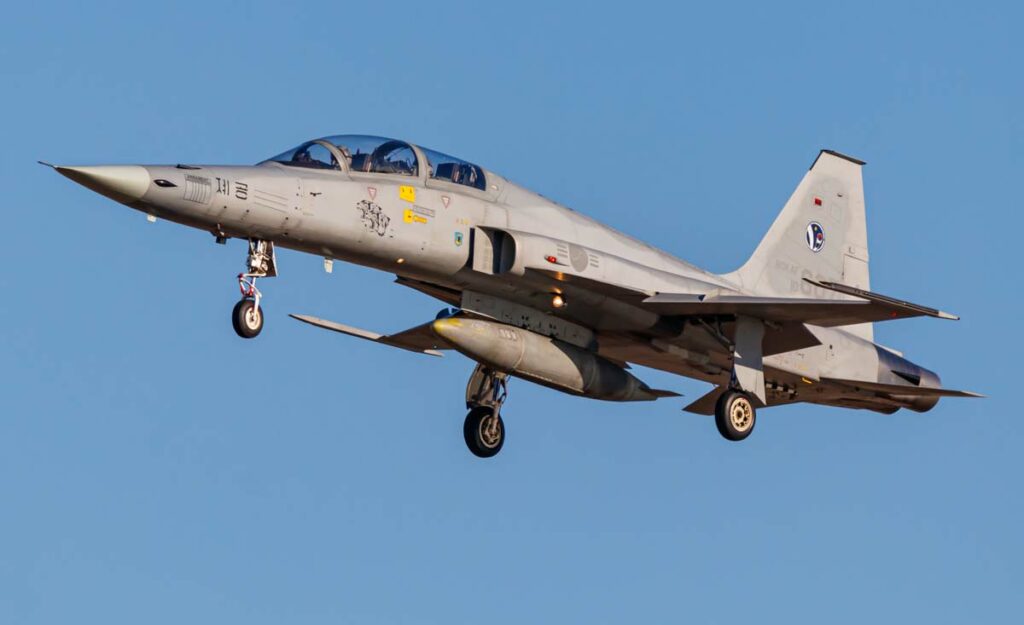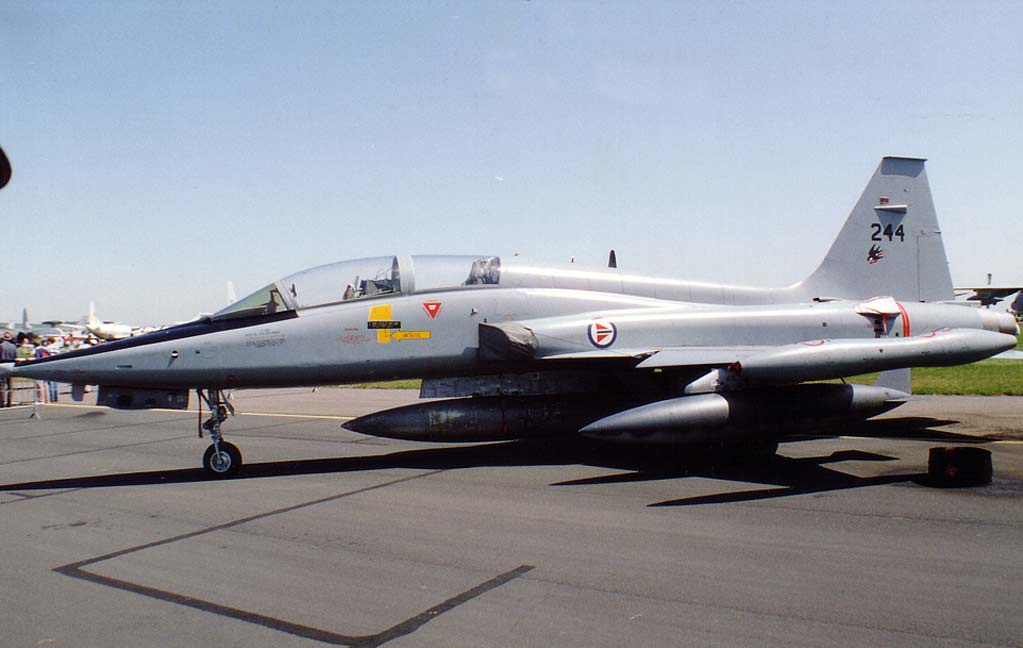Compact, supersonic jet fighter known for its agility, low cost, and operational versatility.
In Brief
The Northrop F-5 Freedom Fighter, a cornerstone of American military aviation, strikes an optimal balance between cost, performance, and ease of maintenance. Introduced in the early 1960s, it features a twin-engine, high agility design that allows for both air-to-air combat and ground-attack missions. Weighing less than many of its contemporaries, the F-5 boasts a top speed of over Mach 1.6, a range of 2,600 kilometers, and a service ceiling above 50,000 feet. It is equipped with two 20mm cannons and has provisions for air-to-air missiles, bombs, and additional fuel tanks on five hardpoints, showcasing its versatility on the battlefield. The aircraft’s design emphasizes simplicity, reliability, and cost-effectiveness, making it a popular choice for the U.S. allies under the Military Assistance Program.

History of the development of the fighter jet
In the context of the Cold War’s escalating arms race, the need for a cost-effective, versatile fighter aircraft that could be easily supplied to allies became apparent to U.S. defense planners. The Northrop F-5 Freedom Fighter emerged from this strategic necessity, designed to provide a high-performance yet economical solution for U.S. allies while maintaining a competitive edge over Soviet aircraft. The development of the F-5 was initiated by Northrop Corporation in the late 1950s, with the aim of producing a lightweight, easy-to-maintain jet that could perform a variety of missions, from air superiority to ground attack.
The F-5 first flew on July 30, 1963, marking the beginning of a prolific career that would see it serve in over 30 countries. Its design philosophy was grounded in providing maximum efficiency and performance at a fraction of the cost of contemporary fighters, making it an attractive option for nations needing to bolster their air defenses without breaking the bank. The NATO nickname for the aircraft, if any, was not as widely publicized as its official designation, emphasizing the direct approach of its naming convention focused on freedom and support for allies.
Design of the Northrop F-5 Freedom Fighter
The F-5’s design is a testament to Northrop’s ingenuity in creating a lightweight, highly maneuverable fighter. The aircraft features a sleek, aerodynamic profile with a twin-engine configuration that ensures a high thrust-to-weight ratio, crucial for its agility and speed. The use of two General Electric J85-GE-13 turbojet engines, each producing 4,080 pounds of thrust (with afterburner), propels the F-5 to speeds exceeding Mach 1.6. The aircraft’s airframe is designed for ease of maintenance and durability, incorporating a straightforward hydraulic system and rugged landing gear for operations from austere fields.
One of the F-5’s notable design elements is its small size and low radar cross-section, making it harder to detect than larger fighters. Its cockpit offers good visibility, and the aircraft employs an effective control system that provides pilots with responsive handling characteristics. The F-5 was among the first fighters to effectively use a leading-edge extension (LEX), which improves its maneuverability and stall characteristics. However, its light armament and limited range compared to larger, more expensive fighters were seen as drawbacks, though these were trade-offs for its cost-effectiveness and operational flexibility.
Performance of the Northrop F-5 Freedom Fighter
The F-5 Freedom Fighter’s performance characteristics are impressive, considering its size and cost. Capable of achieving a top speed of Mach 1.6 (1,060 mph or 1,700 km/h) and a range of 1,400 miles (2,260 kilometers) with external fuel tanks, it can operate from relatively short runways, enhancing its versatility. The aircraft’s service ceiling is above 50,000 feet (15,240 meters), allowing it to engage enemy aircraft at high altitudes. Its agility and speed make it a formidable adversary in air-to-air combat, capable of holding its own against larger and more heavily armed fighters.
In comparison to contemporaries like the Soviet MiG-21, the F-5 demonstrated comparable speed and maneuverability, with the added advantage of lower operational costs and easier maintenance. Its performance in the hands of skilled pilots has been noteworthy, with several instances during training exercises where F-5s, serving as aggressor aircraft, bested more modern and sophisticated fighters through superior tactics and the aircraft’s inherent agility.
Variants of the Northrop F-5 Freedom Fighter
The F-5 family includes several key variants, each designed to enhance the aircraft’s capabilities and adapt to different roles. The initial F-5A Freedom Fighter was followed by the F-5B, a two-seat training version without combat capability. The F-5E Tiger II, introduced in the early 1970
s, featured improved engines, avionics, and a larger wing to enhance its combat effectiveness and versatility. The RF-5E Tigereye provided reconnaissance capabilities with minimal modifications required to the airframe. Each variant of the F-5 was designed to maintain the original aircraft’s advantages of low cost, simplicity, and effectiveness, while expanding its mission capabilities.

Military Use and Combat of the Northrop F-5 Freedom Fighter
The F-5 has seen extensive military use across the globe, serving in the air forces of over 30 countries. Its combat debut came in the latter stages of the Vietnam War, where it conducted air-to-air missions and ground-attack operations. The aircraft’s light armament, typically two 20mm cannons and provisions for missiles and bombs, proved adequate for its multi-role mission profile. The F-5’s reliability and ease of maintenance made it highly valued among its operators, with some countries continuing to use upgraded versions of the aircraft into the 21st century.
The F-5 has been sold to numerous countries, including Switzerland, Brazil, and South Korea, underlining its appeal as an affordable yet capable fighter jet. Its role as an aggressor in training exercises has also highlighted the aircraft’s enduring utility in simulating enemy tactics and capabilities. Despite the emergence of more advanced fighters, the F-5 remains in service with several air forces, testament to its lasting legacy in military aviation.
The Northrop F-5 Freedom Fighter epitomizes the balance between cost, capability, and operational flexibility. Its enduring legacy in global air forces underscores its effectiveness as a multi-role fighter. With its innovative design, commendable performance, and significant impact on air combat strategy, the F-5 remains a pivotal chapter in the history of military aviation, embodying the principles of versatility and economy without compromising on performance.
Back to the Fighter Jet section.